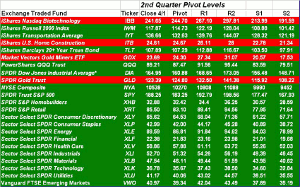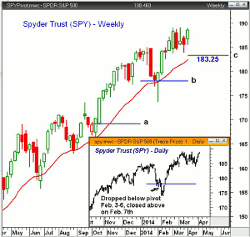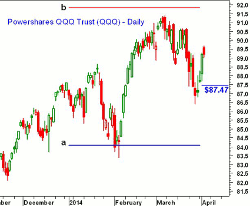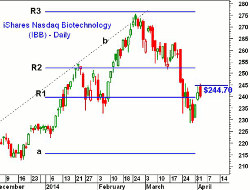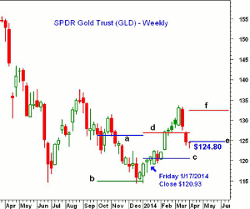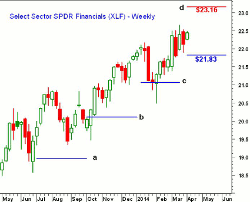A new quarter is upon us, which is why it is important to analyze and interpret the quarterly pivots to determine if they were helpful in navigating the previous quarters' tumultuous markets, says MoneyShow’s Tom Aspray.
As we start a new quarter, it is time to determine whether the quarterly pivots helped one navigate what was a frustrating market for many investors and most traders. In December of 2012, I wrote “The Most Powerful Pivot Level” where I discussed using quarterly pivots which had been shown to me several years ago by John Person.
Since they were going to be featured in his new book, I was able to share his research with my readers. Since then, they have been featured in several other articles and I have been providing a table each quarter that can be used as a reference.
The rather simplistic approach that I use is to watch whether a market average, stock, or ETF has a weekly close above or below their quarterly pivots. I also use the pivot resistance levels as another way to determine upside targets. Sometimes, the quarterly levels will also correspond to weekly or monthly starc bands, which suggests that this level is even more important.
On the table I have highlighted those ETFs (in red) that started off the first day of the quarter by closing below their new quarterly pivots. Those highlighted in green closed, on April 1, above their new quarterly pivots. Several of the ETFs could rally enough by the end of the week to close back above their quarterly pivot levels. This makes Friday’s close, and the reaction to the unemployment report, even more important. It would take a severe decline on Thursday and Friday to drop many of the ETFs below their quarterly pivots.
As I have discussed in prior articles, the Spyder Trust (SPY) did not have a weekly close below its quarterly pivot in 2013. On the chart, line a, represents the fourth quarter pivot for 2013, which was at $167.72. In early October, SPY had a weekly low of $162.92 but rebounded sharply to close the week at $168.60.
For the first quarter of 2014, the pivot was at $177.97, line b. The daily chart insert shows that the sharp drop, on Monday, February 3, took the SPY well below the quarterly pivot, as Wednesday’s low was $172.95. There were signs at the time that this could be a panic low, as it increased the bearish sentiment and the ARMS Index hit an oversold extreme.
The SPY was able to rebound by the end of the week at $178.89, which was well above the quarterly pivot. The 20-week EMA, which has provided good support over the past year, was sharply violated during the early February drop, but not on a closing basis.
For the second quarter, the pivot is at $183.25 with the R1 resistance at $192.79, which corresponds nicely with the upside target from the recently completed trading range. The rising 20-week EMA is at $182.72.
NEXT PAGE: Quarterly Pivot Levels for Securities and Biotech
|pagebreak|The PowerShares QQQ Trust (QQQ) opened the New Year by closing the first week of 2014 well above the quarterly pivot at $84.09, line a. In early February, the QQQ dropped as low as $83.20 on February 5, but closed the week at $86.74. As I suggested last October, one way to avoid panic selling is to “Avoid the Noise, Watch the Numbers,” which was referring to the quarterly pivot levels.
On March 7, the QQQ hit a high of $91.36, which was not too far below the quarterly R2 resistance at $91.83, line b. For the second quarter, the pivot stands at $87.47 with the S1 support at $83.59. On the upside, the R1 resistance is just slightly above the March high at $91.56.
As of the close on Wednesday, April 2, the daily studies for the QQQ are still negative but have turned up. I pointed out last month that the daily relative performance had turned negative and, subsequently, the weekly RS line also dropped below its WMA. The weekly and monthly OBV are still clearly positive.
The biotechnology sector was the hottest sector for most of the first quarter, as the iShares Nasdaq Biotechnology (IBB) ended 2013 at $227.06 and closed on February 25 at $273.20. This was a rise of 20.3%. Subsequently, IBB dropped sharply to a low of $228.68 in late March. It ended the quarter with a gain of just over 4%.
The chart shows that the quarterly R1 and R2 resistance levels were both easily exceeded, as the rally topped out just below the R3 resistance at $276.50. The trend line resistance on the daily chart, line b, was tested as IBB was topping out.
For the second quarter, the pivot stands at $244.70, which is not too far above the April 2 close at $241.60. On a weekly close back above the quarterly pivot, the R1 resistance for the second quarter stands at $267.10.
NEXT PAGE: Quarterly Pivots for Gold and Gold Miners
|pagebreak|It has been a tumultuous past two quarters for gold and the gold miners as they started the last quarter of 2013 below the quarterly pivots. For the week ending October 18, both closed back above the quarterly pivots, but the signals did not last long.
The chart of the SPDR Gold Trust (GLD) shows the move above the quarterly pivot at line a, and then the drop below it two weeks later. The ensuing nine week decline took GLD to a low of $114.50, which was just below the quarterly S1 support at $115.04 (see table).
For the first quarter of 2014, the pivot, line c, was at $120.67, which was overcome on Friday January 17 as GLD closed at $120.93 (see arrow). Over the next eight weeks, GLD rallied to a high of $133.69 on March 14 and was up 15% for the year. GLD easily overcame the R1 resistance at $126.89 by the middle of February.
The decline from the highs has been equally sharp. On April 1, GLD closed at $123.39, which was below the second quarter’s pivot at $124.80. It did have nice gains of just over 7% for the first quarter, but gave up over half of its gains. It could rally back above the pivot by Friday’s close.
As I have noted previously, the weekly OBV on GLD did form a bullish divergence at the December lows that was confirmed by the move above the prior high. The weekly OBV is declining but is still well above its rising WMA.
The daily studies are still negative but are now trying to turn higher. I attempted to buy the pullback but it has been sharper than expected, as the 50% Fibonacci support levels have been violated and my stops were hit.
The Market Vectors Gold Miners (GDX) also tested the 61.8% support but it gapped higher on April 2 on heavy volume. It may close the week back above its second quarter pivot at $24.30.
NEXT PAGE: Quarterly Pivots for Healthcare and Financials
|pagebreak|After breaking out above 12 year resistance in March 2012, the Select Sector SPDR Health Care Sector (XLV) has been a market leading sector. I have included the quarterly pivot levels for all of 2013, as they are labeled as lines a through d.
The fourth quarter pivot (line d) was only briefly violated in October of 2013, as XLV hit a low of $49.58 and was below the quarterly pivot of $50.22. But XLV reversed sharply to the upside by Friday, closing the week at $51.23.
The corrections over the last fifteen months have also held above the rising 20-day EMA, though it was often tested on the corrections (see arrows). The weekly OBV has held well above its rising 21-week WMA since late 2012, as it shows a pattern of higher highs, confirming the price action. Even though the volume was heavy last week, as the biotech sector was hit hard, the OBV has not yet come close to its WMA.
In the first quarter of 2014, the pivot stood at $53.58 and XLV had a low of $54.65 in early February. For the second quarter, the pivot is at $57.88 with XLV currently trading above $59. The R1 resistance is at $61.11, which is about 4% above current levels.
The path for the Select Sector SPDR Financial (XLF) was not quite as clear in 2013. During the second quarter of 2012, the pivot at $17.57 (not shown) was broken by a few cents, but XLF did not have a weekly close below it.
The ETF stayed well above its third quarter pivot, line a, during last summer. Then, on Friday, October 4, XLF closed at $20.05 which was just below the fourth quarter pivot (line b) at $20.11. The following week, XLF rebounded to close at $20.31 and back above its pivot.
There was also quite a bit of volatility in the first quarter of 2014, as the pivot at $21.07 (line c) was violated at the end of January when XLF closed at $21.06. As was the case in October, XLF quickly rebounded and closed the next week at $21.29.
For this quarter, the pivot is at $21.83, which is about 2.6% below current levels. The quarterly R1 resistance is at $23.16, line d, with the weekly starc+ band at $23.28. This is the next potential upside target as $23.16 is about 3.6% above current levels.
As I have mentioned previously, you can easily calculate the quarterly pivots using either a spreadsheet or one of the many on line pivot calculators like the one provided by John Person.
During your weekend, review your positions, you can then compare the week close to the quarterly pivot levels. For new positions, you can look for those stocks or ETFs that are giving positive daily technical signals at their quarterly pivots.

